By Daniel Vaughan. The Pebble Beach Concours d'Elegance took a brief hiatus during 2020 as the world wrestled with the global pandemic, returning in 2021 and coinciding with its celebration of 70 years of competition (technically 71st anniversary). The history of the event dates to 1950 when automobile enthusiasts asked Samuel F. B. Morse, the founder of Pebble Beach, if they could hold a race on the roads of Del Monte Forest. With approval, another element was added to compliment the speed competition - one to celebrate style and social grace - and thus, the Concours was born.
This year's event celebrated its legacy and history through special classes housing 38 of the previous Best of Show winners, many having remained with the same owners who raised the trophy overhead, and with five of the Pebble Beach Road Race winners. Additionally, as an acknowledgment of the very first special display, a curated display of La Carrera Panamericana cars from 1953 was on display.
The extensive and comprehensive list of featured classes included Porsche 917, the centenary of the first American win at the French Grand Prix in 1921, Lamborghini Countach 50th Anniversary, Millers of Indianapolis Speedway fame, Early Electric Car class, the Cars of Iso, and a celebration of Pinin Farina's past.
Well over half of the magnificent cars that have taken the top award, Best of Show, over the past seven decades, were on display at the edge of Carmel Bay. It was a rare opportunity to enjoy these celebrated vehicles side-by-side, and appreciate the elegance, and evolution of styling and preferences over the years. During the events earlier years, elegance was often equated with interior luxury and comfort, with preferences favoring formal town cars. The paradigm shifted during the 1960s when preferences embraced more dynamic and sporty personalities, with Best of Show winners being awarded to two-seater cabriolets, roadsters, and speedsters. The sharp perpendicular contours of the Town Cars gave way to more modern and curvaceous forms. The theme of the 1980s and 1990s revolved around restoration - often, over restoration - with the cars returning to their original, and in many cases, better than original condition. The pursuit of perfection led to a new appreciation and understanding of original and unrestored cars. As the saying goes, 'They're only original once.' During the early 2000s, special classes for preservation cars were introduced, and they have become increasingly considered for the top award. More recently, the balance of cars on the Concours show field has tipped, with the majority of prewar cars being displaced by those from the post-war era.
The magnificent display of previous Best of Show winners was a display of the evolution of elegance, the styles that influenced the respected periods, and the agreed-upon pinnacle of the collector car world at that moment.
The Elegance of Motorsport Competition
More than just a celebration of the paragons of luxury, style, and elegance, the Pebble Beach Concours d'Elegance tells the history of the automobile. It recognizes mechanical sophistication, ingenuity, and successful designs that led to all-conquering periods of motorsport competition. Included in this year's categories were the Porsche 917, cars of the La Carrera Panamericana, the 1921 French Grand Prix, cars of Harry Miller, Ferrari Competition, and Postwar Racing.
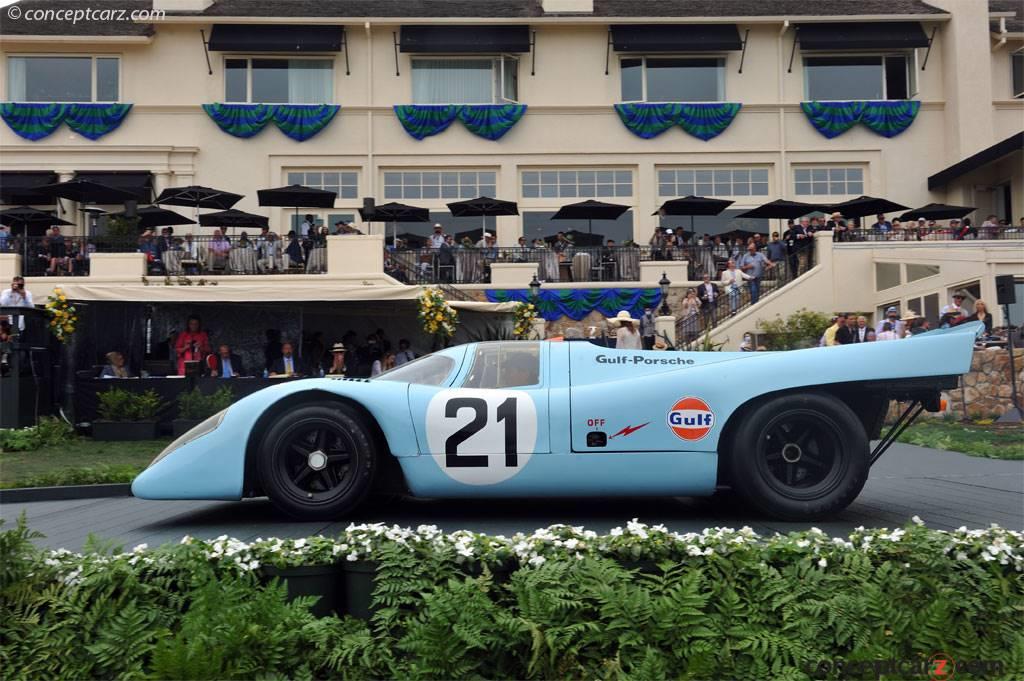
The Porsche 917
Over a dozen Porsche 917s were put on display and originally intended to be displayed in 2020, honoring the 50th anniversary of a 917 winning the 24 Hours of Le Mans—Porsche's first overall victory there. With the concours being canceled, Porsche enthusiasts had to wait until 2021. Since a 917 also won at Le Mans in 1971, fans were able to celebrate that anniversary as well. The 917 gave the German manufacturer its first overall victory at the 24 Hours of LeMans, won numerous victories during its racing career, and still holds the fastest lap at the Le Man's racing circuit to this day. The 1969 Porsche 917K Coupe owned by Chris MacAllister (chassis 917-016) was awarded Best in Class. It was the JWA/Gulf team's primary car during the 1970 season and currently wears its race-winning 1970 Watkins Glen livery and configuration. It is the last largely unrestored 917 still being raced anywhere in the world.
The Cars of Harry Miller
Modified stock cars had dominated motorsports competition through the first two decades of the 20th century, but by the 1920s, they began losing ground to purpose-built racers. Between 1919 and 1929, the purpose-built racers from Duesenberg and Miller dominated the scene, alternating wins at the Indianapolis 500 race. Duesenberg introduced centrifugal supercharging to the speedway in 1924, with forced induction by means of a gear-driven compression. Harry Miller took notice and soon applied supercharging to his own racing engines. His cars were innovative, light, and powerful, earning nine victories in thirteen years at the Indiapnolis 500, and finishing second in eight of those races. Twelve examples of his work were on display at Pebble Beach, with the judges selecting the 1926 Miller 91 Perfect Circle Special owned by Tom & Suzie Barbour as their favorite. When racing regulations changed for the 1926 racing season, limiting engine displacement to 1.5 liters (91 cubic inches), Harry Miller and his talented engineers and designers created an entirely new car. The resulting Type 91 had no commonality of parts with its predecessor, the Type 122 (albeit, except for the outside purchased parts such as the wheels/tires, instrumentation, etc), and were virtually identical in appearance, with the exception of the 91's three-piece radiator and grille assembly. The Type 91 engines were supercharged, initially delivering 155 horsepower but after continual refinements, were raised to over 250 horsepower. The Miller 91 was so successful that it dominated on speedways of the 1920s, eventually leading to the AAA introducing new rules for 1930. The 'Perfect Circle Special' is a faithful recreation using many original parts (there are no known original Miller 91 rear-drive cars surviving). It is the car that won the 1926 Indianapolis 500 driven by Frank Lockhart and is one of nine rear-wheel-drive 91s built by Miller. There were also ten front-wheel-drive versions of the 91 built over a three-year period.
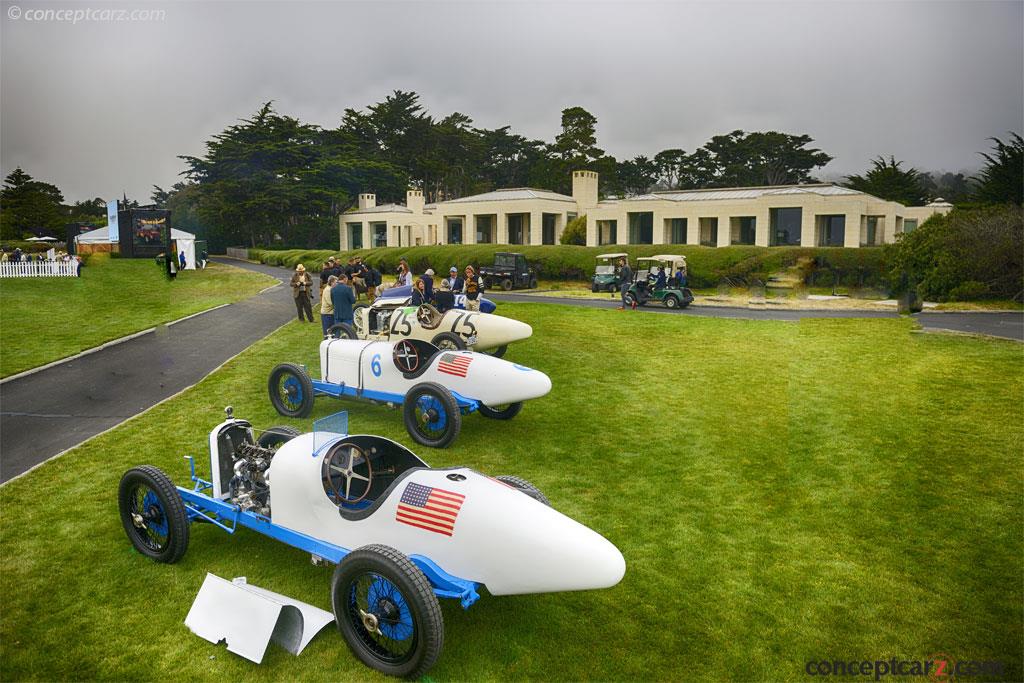
The 1921 French Grand Prix Centennial
Just nine cars were left to contest the 1921 French Grand Prix after late cancellations by Fiat and Sunbeam, but four additional entries by Duesenberg brought the grid to 13. The 183 cubic-inch inline eight-cylinder engines of the Duesenberg lacked the power of the competition, but the hydraulic brakes on all four wheels gave them an advantage. Duesenberg drivers Jimmy Murphy, Andre Dubonnet, and Albert Guyot finished 1st, 4th and 6th place, while Joe Boyer's Duesenberg did not finish. Four of the cars were on display at Pebble Beach, including three Duesenbergs and a Ballot 3LR. Although the racing Duesenbergs were devoid of frame numbers, it is believed that the example from the Rob Kauffman collection was the car that Guyot drove to victory. It survives with its original 183 racing engine and its original Miller carburetors and recently received a restoration.
Elegance For the Road
Fashion and design have had a symbiotic relationship with the automobile industry since its inception, inspiring new trends and developments, and the constant pursuit of luxury and ease of motoring. Among the pinnacles who have personified craftsmanship and beauty since the 1930s was Pininfarina, perhaps most successfully when paired with the refined chassis from Enzo Ferrari. Pebble Beach's in-depth study of its history was via four dedicated classes entitled 'Pinin Farina Prewar', 'Pininfarina Postwar,' 'Pinin Farina Ferrari Early,' and 'Pininfarina Ferrari Late.

Pinin Farina Prewar
The 1938 Lancia Astura Pinin Farina Cabriolet owned by Filippo Sole of Milan, Italy was the judge's favorite for the most elegant Pinin Farina Prewar car on the field. The Astura was produced from 1931 to 1939 in four separate series, with production being exclusive, with fewer than 3,000 examples created of which 426 received the long-wheelbase Series IV platform that was first introduced in 1937. The unique styling created by Pinin Farina was lower than other Astura's from the same period, with a unique radiator grille and rear-hinged doors. Its original owner took possession just prior to the outbreak of war in 1939, and to avoid damage, the car was disassembled and stored in the basement of the owner's factory six weeks after delivery. After his passing, the car was largely forgotten and when his grandson sold the factory in 1990 and the basement was cleared, the car was discovered. With all of its original components intact, the car received a restoration, was shown at various European events, and entered the car of its current owner in 2014.
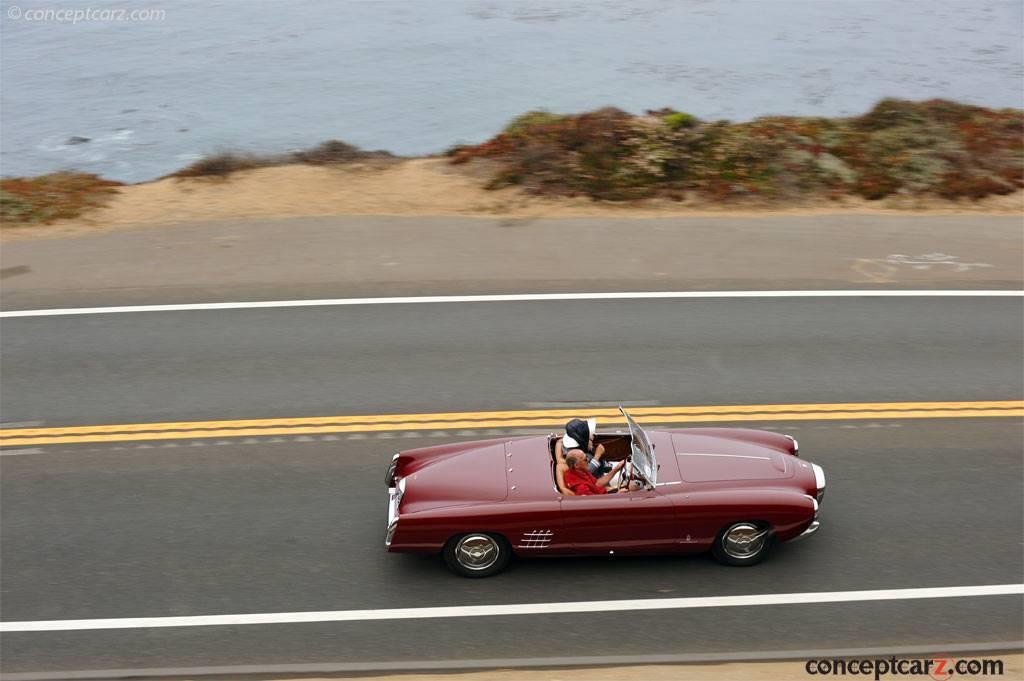
Pininfarina Postwar
The most elegant postwar-bodied Pininfarina car also rested on a Lancia chassis and many of its styling cues were inspired by the Lancia Aprilia Pinin Farina Aerodynamica Berlinettas. The jet age was profoundly influential in many of the styling elements, resulting in one of the era's more outlandish designs. Named the PF200, it featured a pronounced oval grille-surround that could have come straight off a fighter jet. Pinin Farina created a total of six PF200 Aurelias show cars and no two were exactly the same. The class-winning PF200 was the only true roadster designated the PF 200-C and was the show car in the 1953 motor shows of Geneva, Paris, and Frankfurt.
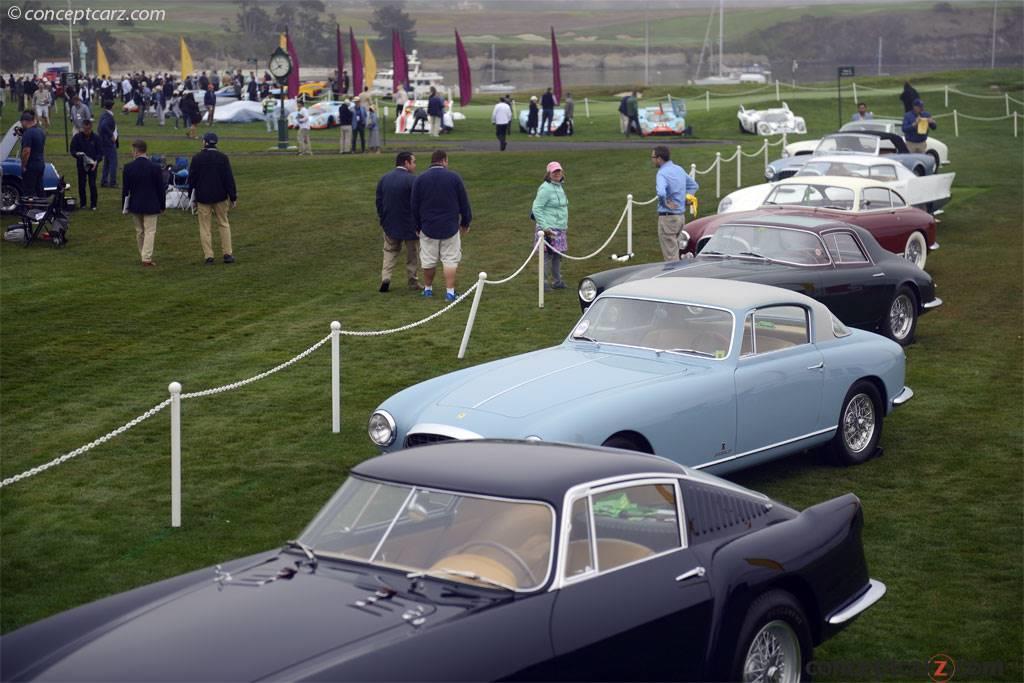
Pinin Farina Ferrari Early
The 1953 Ferrari selected as the Best in Class was the first of ten 375 Americas constructed and was the car displayed at the 1953 Paris Auto Salon and the Geneva Auto Show in 1953. Its coachwork was a refinement of the design applied on the 212 Inter models and the 375 was the basis for Ferrari's first production car, the 250 Europa GT. Being the first model in this range, this particular car was hugely important for the small Italian manufacturer and led the way for subsequent classic Ferraris, including the 410 Superamerica, the 400 Superamerica, and eventually, the 500 Superfast built between 1953 and 1966. The car is currently owned by Jamie & Cecilia Muldoon of Guadalajara, Mexico
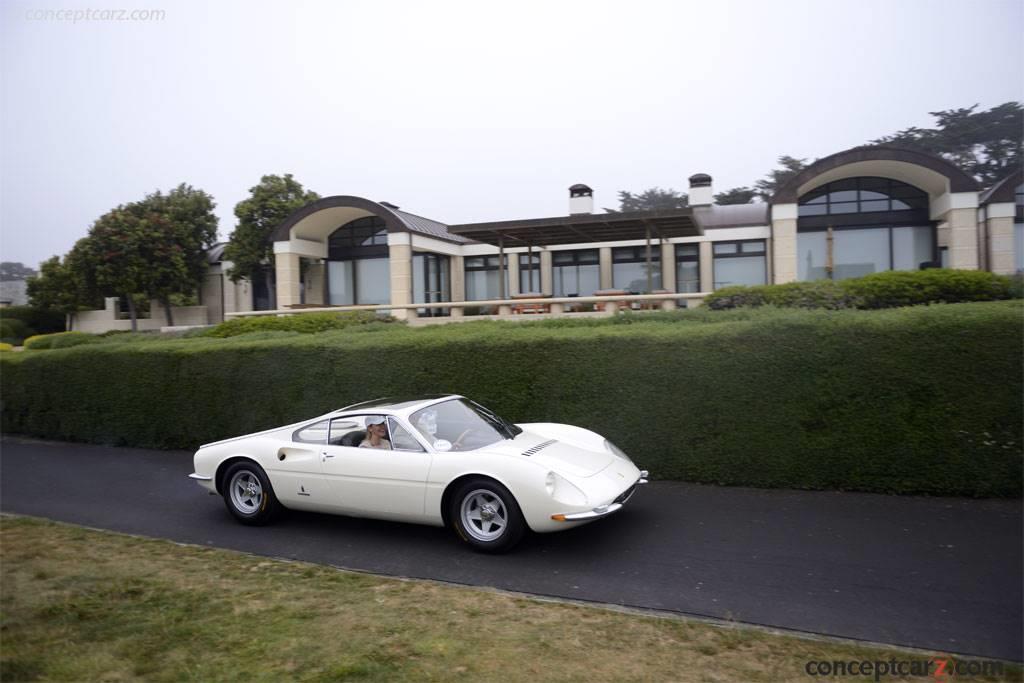
Pininfarina Ferrari Late
Two Ferrari 365 P chassis were ordered by Fiat Boss Gianni Angelli and clothed by Pininfarina in 1966, with the Pebble Beach Best in Class winner being the first and the car displayed at the 1966 Paris Motor Show. Unusual for a Ferrari at the time, it has a mid-engine configuration and seating for three, with the driver's seat positioned at the center of the car. The car was later sent to Chinetti Motors in July of 1967, owned by a handful of caretakers before re-entering the Chinetti family's care. It was occasionally shown until December 2017 when Luigi Chinetti Jr. sold it to the current owner.
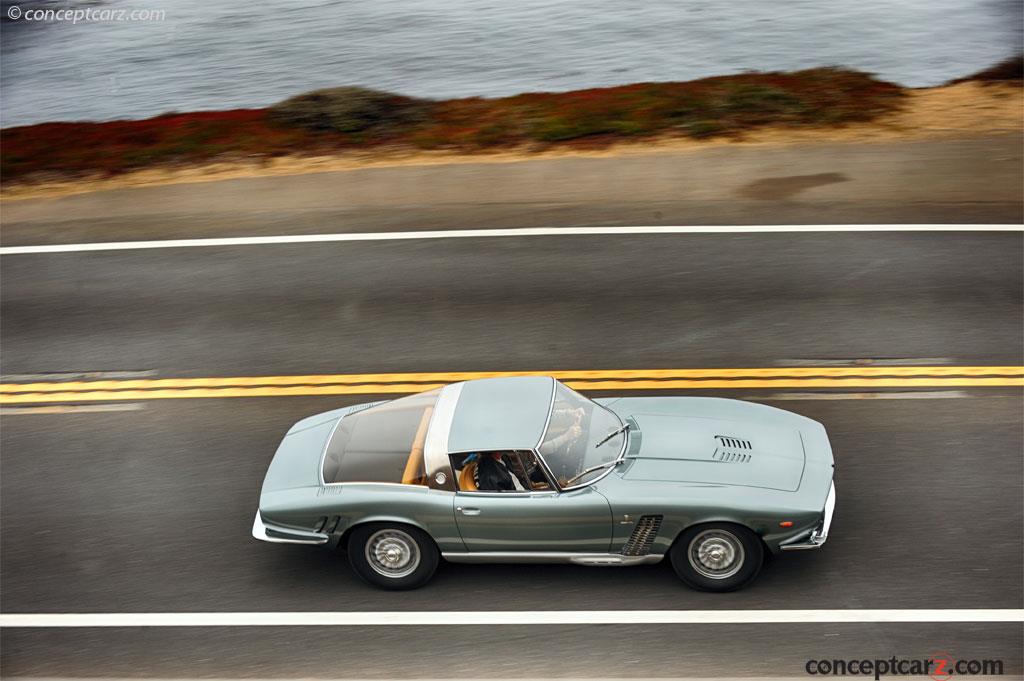
The Iso Story
Renzo Rivolta and his Iso company were very successful during the 1950s manufacturing refrigerators and heating units, then became Italy's third-largest motor scooter manufacturer. Their first foray into the automotive arena was with the Iso Isetta bubblecar, introduced in 1953, and later licensed to BMW and others. With ambition, engineering talent, and the necessary financial footing, Iso ventured into the competitive sports and GT market. The first product was the Iso Rivolta GT resting on a wedge-steel platform chassis that was more sophisticated than those produced by Maserati or Ferrari at the time. Beneath the graceful bonnet was powerful and reliable Chevrolet small-block V8s. The two-seat Grifo followed in 1963, making its debut at the Turin Auto Show. The Grifo A3/L version was intended to compete with the world's best road cars, while the more radical Grifo A3/C was intended for long-distance competition. In 1964 and 1965, the A3/C scored class victories at Le Mans. In 1972, Iso introduced a radical mid-engined Varedo prototype at the Turin Auto Show, and the following year, ISO entered Formula 1 competition, teaming up with Frank Williams.
The display of Iso vehicles at the Pebble Beach Concours included the Grifo, Rivolta, and the four-door Fidia designed by Giorgetto Giugiaro. The 1963 Iso Grifo A3/L Prototype Bertone Coupe owned by Peter Wilde of Brookline, Massachusetts was awarded Best in Class honors. It made its debut in 1963 at the Torino Auto Show and would remain on the show circuit throughout much of 1964 and even made its way to the New York Auto Show on display at the J.S. Inskip stand. Its Corvette 327 cubic-inch V8 engine delivers 340 horsepower and a top speed of 171 mph. There are numerous unique features that did not make it into the production cars, including the unique hood and the stainless-steel wraparound roof band.
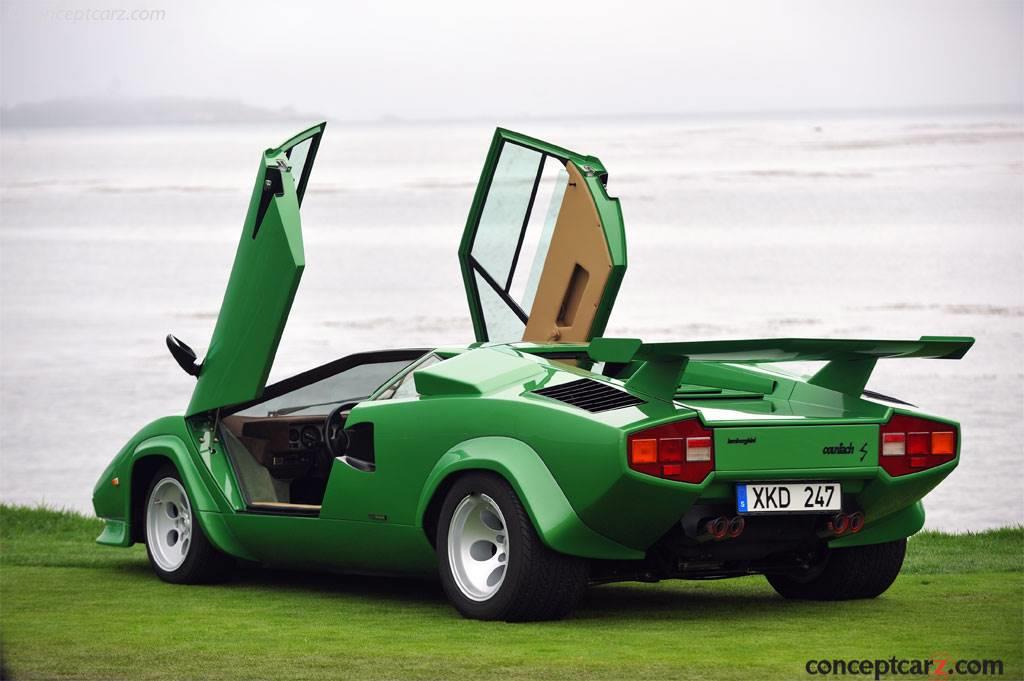
50 Years of the Countach
The Lamborghini Countach prototype was introduced in 1971 at the Geneva Motor Show, its design having been foreshadowed the previous year by the Lancia Stratos Zero concept car. Production commenced in 1974 and continued through 1990 with nearly 2,000 examples built. Its exotic wedge-shaped design covering the rear mid-engine, rear-wheel-drive sports car was penned by Italian design house Bertone, pioneering and popularizing the radically angled 'Italian Wedge' shape. The examples displayed at Pebble Beach were some of the most unique, including the LP400 Bertone Berlinetta owned by Automobili Lamborghini S.p.A. It is the earliest surviving prototype created and was originally painted red with a black interior when it appeared in March of 1973 at the Geneva Motor Show. It was repainted green (Verde Medio), over a light green interior (Verde Chiaro), and was shown at the Paris Show, followed by Frankfurt and Earl Court, London. It was used as the master model for every Countach that followed.
The judges awarded the 1981 Lamborghini Countach LP400S Series III Bertone Berlinetta owned by Robert Bishop of Palm Beach, Florida as their Best in Class winner.
Best of Show
230 collector cars were entered for competition at the 2021 Pebble Beach Concours d'Elegance, with the 1938 Mercedes-Benz 540K Autobahn Kurier belonging to The Keller Collection at The Pyramids in Petaluma, California earning the coveted Best of Show honors. 'This Best of Show winner embodies so many sensational features—styling, speed, and performance. Unveiled at the Berlin Auto Show and built to rule the new German Autobahn in 1938, this rare automobile is truly an example of beautiful German design,' said Concours Chairman Sandra Button. 'It's my triple crown,' said Arturo Keller. 'This is the only remaining car of its kind, and I am the second owner from new. It's a very special car, and we are very happy.' The car was last restored in 2006 and has continued to be shown, rallied, and toured since then. The Kellers also go home with the Elegance in Motion Trophy.
This year's race for Best of Show featured other strong contenders, including Joanie & Scott Kriens' 1937 Bugatti Type 57S Corsica Drophead Coupé; the 1966 Ferrari 365 P Pininfarina Berlinetta Speciale shown by RQ Collections; and Jonathan & Wendy Segal's 1956 Maserati A6G Zagato Coupé.
This win is the ninth for Mercedes-Benz, tying the marque with Bugatti for the most Best of Shows at Pebble Beach.
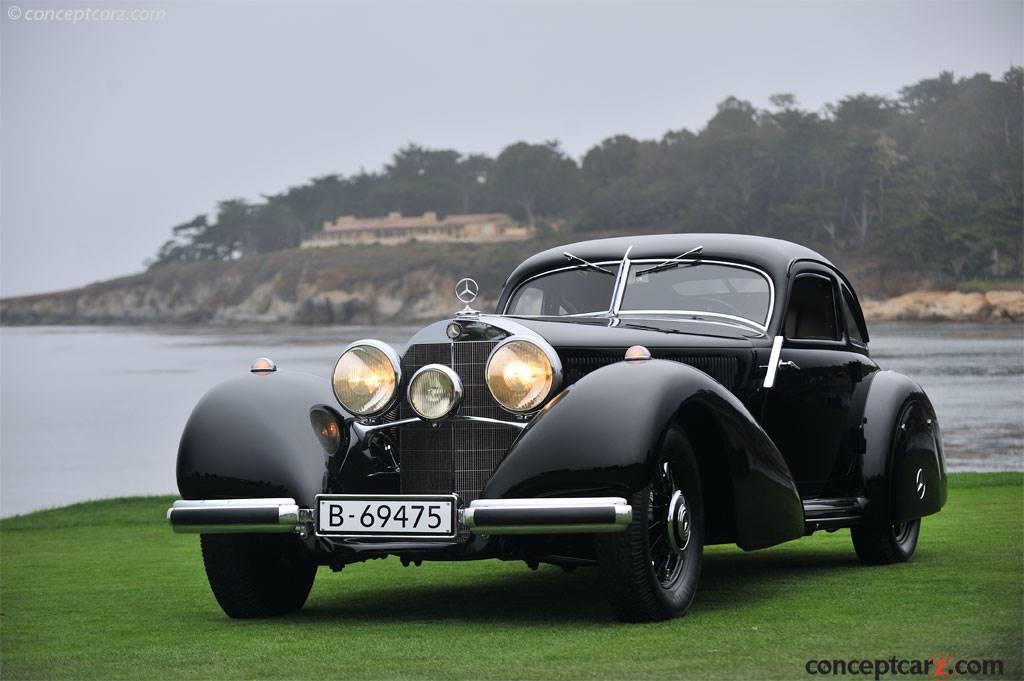
1938 Mercedes-Benz 540K Autobahn Kurier
The name 'Autobahn-Kurier' means 'Highway Kurier,' intended primarily for Germany's newly constructed AUtobahn. These were exclusive vehicles with advanced engineering and superlative performance, with four examples built on the 500K chassis and two 'Autobahn-Kurier' on the 540K chassis. It was a body style offered by the Sindelfingen factory and was first seen on the 1935 Mercedes-Benz 500K chassis. Its teardrop shape took advantage of the modern-day aerodynamic design principles with a shape aimed to lower air resistance. Two chassis lengths were available, either 3290mm or 2980mm. The Keller's Autobahn Kurier is the only one still in existence and still sporting its original equipment.
Pebble Beach Company Foundation
The Pebble Beach Concours raised more than $1.75 million for charity this year, bringing the event's total charitable donations to over $32 million to date. Through the Pebble Beach Company Foundation, the primary charitable partner of the Concours, these funds will benefit more than 95 local charities, impacting the lives of more than 10,000 children annually in Monterey County.
The 71st Pebble Beach Concours d'Elegance will take place on Sunday, August 21, 2022, and will celebrate Lincoln and Talbot-Lago Grand Sport, with additional special classes to be announced soon.
This year's event celebrated its legacy and history through special classes housing 38 of the previous Best of Show winners, many having remained with the same owners who raised the trophy overhead, and with five of the Pebble Beach Road Race winners. Additionally, as an acknowledgment of the very first special display, a curated display of La Carrera Panamericana cars from 1953 was on display.
The extensive and comprehensive list of featured classes included Porsche 917, the centenary of the first American win at the French Grand Prix in 1921, Lamborghini Countach 50th Anniversary, Millers of Indianapolis Speedway fame, Early Electric Car class, the Cars of Iso, and a celebration of Pinin Farina's past.
Well over half of the magnificent cars that have taken the top award, Best of Show, over the past seven decades, were on display at the edge of Carmel Bay. It was a rare opportunity to enjoy these celebrated vehicles side-by-side, and appreciate the elegance, and evolution of styling and preferences over the years. During the events earlier years, elegance was often equated with interior luxury and comfort, with preferences favoring formal town cars. The paradigm shifted during the 1960s when preferences embraced more dynamic and sporty personalities, with Best of Show winners being awarded to two-seater cabriolets, roadsters, and speedsters. The sharp perpendicular contours of the Town Cars gave way to more modern and curvaceous forms. The theme of the 1980s and 1990s revolved around restoration - often, over restoration - with the cars returning to their original, and in many cases, better than original condition. The pursuit of perfection led to a new appreciation and understanding of original and unrestored cars. As the saying goes, 'They're only original once.' During the early 2000s, special classes for preservation cars were introduced, and they have become increasingly considered for the top award. More recently, the balance of cars on the Concours show field has tipped, with the majority of prewar cars being displaced by those from the post-war era.
The magnificent display of previous Best of Show winners was a display of the evolution of elegance, the styles that influenced the respected periods, and the agreed-upon pinnacle of the collector car world at that moment.
The Elegance of Motorsport Competition
More than just a celebration of the paragons of luxury, style, and elegance, the Pebble Beach Concours d'Elegance tells the history of the automobile. It recognizes mechanical sophistication, ingenuity, and successful designs that led to all-conquering periods of motorsport competition. Included in this year's categories were the Porsche 917, cars of the La Carrera Panamericana, the 1921 French Grand Prix, cars of Harry Miller, Ferrari Competition, and Postwar Racing.

The Porsche 917
Over a dozen Porsche 917s were put on display and originally intended to be displayed in 2020, honoring the 50th anniversary of a 917 winning the 24 Hours of Le Mans—Porsche's first overall victory there. With the concours being canceled, Porsche enthusiasts had to wait until 2021. Since a 917 also won at Le Mans in 1971, fans were able to celebrate that anniversary as well. The 917 gave the German manufacturer its first overall victory at the 24 Hours of LeMans, won numerous victories during its racing career, and still holds the fastest lap at the Le Man's racing circuit to this day. The 1969 Porsche 917K Coupe owned by Chris MacAllister (chassis 917-016) was awarded Best in Class. It was the JWA/Gulf team's primary car during the 1970 season and currently wears its race-winning 1970 Watkins Glen livery and configuration. It is the last largely unrestored 917 still being raced anywhere in the world.
The Cars of Harry Miller
Modified stock cars had dominated motorsports competition through the first two decades of the 20th century, but by the 1920s, they began losing ground to purpose-built racers. Between 1919 and 1929, the purpose-built racers from Duesenberg and Miller dominated the scene, alternating wins at the Indianapolis 500 race. Duesenberg introduced centrifugal supercharging to the speedway in 1924, with forced induction by means of a gear-driven compression. Harry Miller took notice and soon applied supercharging to his own racing engines. His cars were innovative, light, and powerful, earning nine victories in thirteen years at the Indiapnolis 500, and finishing second in eight of those races. Twelve examples of his work were on display at Pebble Beach, with the judges selecting the 1926 Miller 91 Perfect Circle Special owned by Tom & Suzie Barbour as their favorite. When racing regulations changed for the 1926 racing season, limiting engine displacement to 1.5 liters (91 cubic inches), Harry Miller and his talented engineers and designers created an entirely new car. The resulting Type 91 had no commonality of parts with its predecessor, the Type 122 (albeit, except for the outside purchased parts such as the wheels/tires, instrumentation, etc), and were virtually identical in appearance, with the exception of the 91's three-piece radiator and grille assembly. The Type 91 engines were supercharged, initially delivering 155 horsepower but after continual refinements, were raised to over 250 horsepower. The Miller 91 was so successful that it dominated on speedways of the 1920s, eventually leading to the AAA introducing new rules for 1930. The 'Perfect Circle Special' is a faithful recreation using many original parts (there are no known original Miller 91 rear-drive cars surviving). It is the car that won the 1926 Indianapolis 500 driven by Frank Lockhart and is one of nine rear-wheel-drive 91s built by Miller. There were also ten front-wheel-drive versions of the 91 built over a three-year period.

The 1921 French Grand Prix Centennial
Just nine cars were left to contest the 1921 French Grand Prix after late cancellations by Fiat and Sunbeam, but four additional entries by Duesenberg brought the grid to 13. The 183 cubic-inch inline eight-cylinder engines of the Duesenberg lacked the power of the competition, but the hydraulic brakes on all four wheels gave them an advantage. Duesenberg drivers Jimmy Murphy, Andre Dubonnet, and Albert Guyot finished 1st, 4th and 6th place, while Joe Boyer's Duesenberg did not finish. Four of the cars were on display at Pebble Beach, including three Duesenbergs and a Ballot 3LR. Although the racing Duesenbergs were devoid of frame numbers, it is believed that the example from the Rob Kauffman collection was the car that Guyot drove to victory. It survives with its original 183 racing engine and its original Miller carburetors and recently received a restoration.
Elegance For the Road
Fashion and design have had a symbiotic relationship with the automobile industry since its inception, inspiring new trends and developments, and the constant pursuit of luxury and ease of motoring. Among the pinnacles who have personified craftsmanship and beauty since the 1930s was Pininfarina, perhaps most successfully when paired with the refined chassis from Enzo Ferrari. Pebble Beach's in-depth study of its history was via four dedicated classes entitled 'Pinin Farina Prewar', 'Pininfarina Postwar,' 'Pinin Farina Ferrari Early,' and 'Pininfarina Ferrari Late.

Pinin Farina Prewar
The 1938 Lancia Astura Pinin Farina Cabriolet owned by Filippo Sole of Milan, Italy was the judge's favorite for the most elegant Pinin Farina Prewar car on the field. The Astura was produced from 1931 to 1939 in four separate series, with production being exclusive, with fewer than 3,000 examples created of which 426 received the long-wheelbase Series IV platform that was first introduced in 1937. The unique styling created by Pinin Farina was lower than other Astura's from the same period, with a unique radiator grille and rear-hinged doors. Its original owner took possession just prior to the outbreak of war in 1939, and to avoid damage, the car was disassembled and stored in the basement of the owner's factory six weeks after delivery. After his passing, the car was largely forgotten and when his grandson sold the factory in 1990 and the basement was cleared, the car was discovered. With all of its original components intact, the car received a restoration, was shown at various European events, and entered the car of its current owner in 2014.

Pininfarina Postwar
The most elegant postwar-bodied Pininfarina car also rested on a Lancia chassis and many of its styling cues were inspired by the Lancia Aprilia Pinin Farina Aerodynamica Berlinettas. The jet age was profoundly influential in many of the styling elements, resulting in one of the era's more outlandish designs. Named the PF200, it featured a pronounced oval grille-surround that could have come straight off a fighter jet. Pinin Farina created a total of six PF200 Aurelias show cars and no two were exactly the same. The class-winning PF200 was the only true roadster designated the PF 200-C and was the show car in the 1953 motor shows of Geneva, Paris, and Frankfurt.

Pinin Farina Ferrari Early
The 1953 Ferrari selected as the Best in Class was the first of ten 375 Americas constructed and was the car displayed at the 1953 Paris Auto Salon and the Geneva Auto Show in 1953. Its coachwork was a refinement of the design applied on the 212 Inter models and the 375 was the basis for Ferrari's first production car, the 250 Europa GT. Being the first model in this range, this particular car was hugely important for the small Italian manufacturer and led the way for subsequent classic Ferraris, including the 410 Superamerica, the 400 Superamerica, and eventually, the 500 Superfast built between 1953 and 1966. The car is currently owned by Jamie & Cecilia Muldoon of Guadalajara, Mexico

Pininfarina Ferrari Late
Two Ferrari 365 P chassis were ordered by Fiat Boss Gianni Angelli and clothed by Pininfarina in 1966, with the Pebble Beach Best in Class winner being the first and the car displayed at the 1966 Paris Motor Show. Unusual for a Ferrari at the time, it has a mid-engine configuration and seating for three, with the driver's seat positioned at the center of the car. The car was later sent to Chinetti Motors in July of 1967, owned by a handful of caretakers before re-entering the Chinetti family's care. It was occasionally shown until December 2017 when Luigi Chinetti Jr. sold it to the current owner.

The Iso Story
Renzo Rivolta and his Iso company were very successful during the 1950s manufacturing refrigerators and heating units, then became Italy's third-largest motor scooter manufacturer. Their first foray into the automotive arena was with the Iso Isetta bubblecar, introduced in 1953, and later licensed to BMW and others. With ambition, engineering talent, and the necessary financial footing, Iso ventured into the competitive sports and GT market. The first product was the Iso Rivolta GT resting on a wedge-steel platform chassis that was more sophisticated than those produced by Maserati or Ferrari at the time. Beneath the graceful bonnet was powerful and reliable Chevrolet small-block V8s. The two-seat Grifo followed in 1963, making its debut at the Turin Auto Show. The Grifo A3/L version was intended to compete with the world's best road cars, while the more radical Grifo A3/C was intended for long-distance competition. In 1964 and 1965, the A3/C scored class victories at Le Mans. In 1972, Iso introduced a radical mid-engined Varedo prototype at the Turin Auto Show, and the following year, ISO entered Formula 1 competition, teaming up with Frank Williams.
The display of Iso vehicles at the Pebble Beach Concours included the Grifo, Rivolta, and the four-door Fidia designed by Giorgetto Giugiaro. The 1963 Iso Grifo A3/L Prototype Bertone Coupe owned by Peter Wilde of Brookline, Massachusetts was awarded Best in Class honors. It made its debut in 1963 at the Torino Auto Show and would remain on the show circuit throughout much of 1964 and even made its way to the New York Auto Show on display at the J.S. Inskip stand. Its Corvette 327 cubic-inch V8 engine delivers 340 horsepower and a top speed of 171 mph. There are numerous unique features that did not make it into the production cars, including the unique hood and the stainless-steel wraparound roof band.

50 Years of the Countach
The Lamborghini Countach prototype was introduced in 1971 at the Geneva Motor Show, its design having been foreshadowed the previous year by the Lancia Stratos Zero concept car. Production commenced in 1974 and continued through 1990 with nearly 2,000 examples built. Its exotic wedge-shaped design covering the rear mid-engine, rear-wheel-drive sports car was penned by Italian design house Bertone, pioneering and popularizing the radically angled 'Italian Wedge' shape. The examples displayed at Pebble Beach were some of the most unique, including the LP400 Bertone Berlinetta owned by Automobili Lamborghini S.p.A. It is the earliest surviving prototype created and was originally painted red with a black interior when it appeared in March of 1973 at the Geneva Motor Show. It was repainted green (Verde Medio), over a light green interior (Verde Chiaro), and was shown at the Paris Show, followed by Frankfurt and Earl Court, London. It was used as the master model for every Countach that followed.
The judges awarded the 1981 Lamborghini Countach LP400S Series III Bertone Berlinetta owned by Robert Bishop of Palm Beach, Florida as their Best in Class winner.
Best of Show
230 collector cars were entered for competition at the 2021 Pebble Beach Concours d'Elegance, with the 1938 Mercedes-Benz 540K Autobahn Kurier belonging to The Keller Collection at The Pyramids in Petaluma, California earning the coveted Best of Show honors. 'This Best of Show winner embodies so many sensational features—styling, speed, and performance. Unveiled at the Berlin Auto Show and built to rule the new German Autobahn in 1938, this rare automobile is truly an example of beautiful German design,' said Concours Chairman Sandra Button. 'It's my triple crown,' said Arturo Keller. 'This is the only remaining car of its kind, and I am the second owner from new. It's a very special car, and we are very happy.' The car was last restored in 2006 and has continued to be shown, rallied, and toured since then. The Kellers also go home with the Elegance in Motion Trophy.
This year's race for Best of Show featured other strong contenders, including Joanie & Scott Kriens' 1937 Bugatti Type 57S Corsica Drophead Coupé; the 1966 Ferrari 365 P Pininfarina Berlinetta Speciale shown by RQ Collections; and Jonathan & Wendy Segal's 1956 Maserati A6G Zagato Coupé.
This win is the ninth for Mercedes-Benz, tying the marque with Bugatti for the most Best of Shows at Pebble Beach.

1938 Mercedes-Benz 540K Autobahn Kurier
The name 'Autobahn-Kurier' means 'Highway Kurier,' intended primarily for Germany's newly constructed AUtobahn. These were exclusive vehicles with advanced engineering and superlative performance, with four examples built on the 500K chassis and two 'Autobahn-Kurier' on the 540K chassis. It was a body style offered by the Sindelfingen factory and was first seen on the 1935 Mercedes-Benz 500K chassis. Its teardrop shape took advantage of the modern-day aerodynamic design principles with a shape aimed to lower air resistance. Two chassis lengths were available, either 3290mm or 2980mm. The Keller's Autobahn Kurier is the only one still in existence and still sporting its original equipment.
Pebble Beach Company Foundation
The Pebble Beach Concours raised more than $1.75 million for charity this year, bringing the event's total charitable donations to over $32 million to date. Through the Pebble Beach Company Foundation, the primary charitable partner of the Concours, these funds will benefit more than 95 local charities, impacting the lives of more than 10,000 children annually in Monterey County.
The 71st Pebble Beach Concours d'Elegance will take place on Sunday, August 21, 2022, and will celebrate Lincoln and Talbot-Lago Grand Sport, with additional special classes to be announced soon.